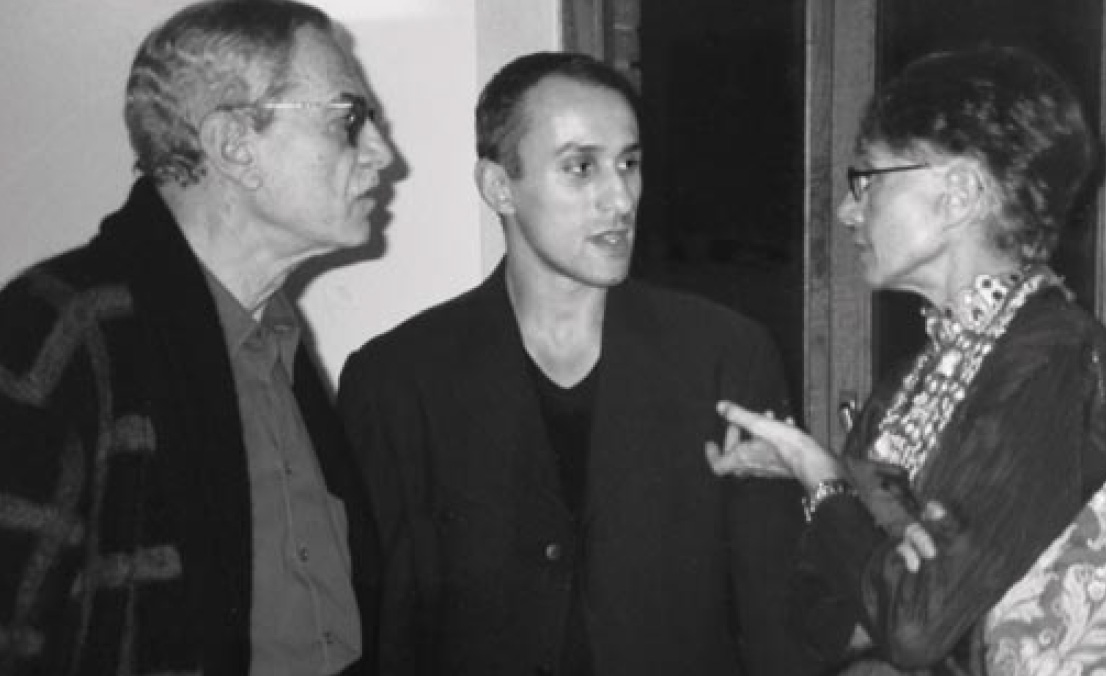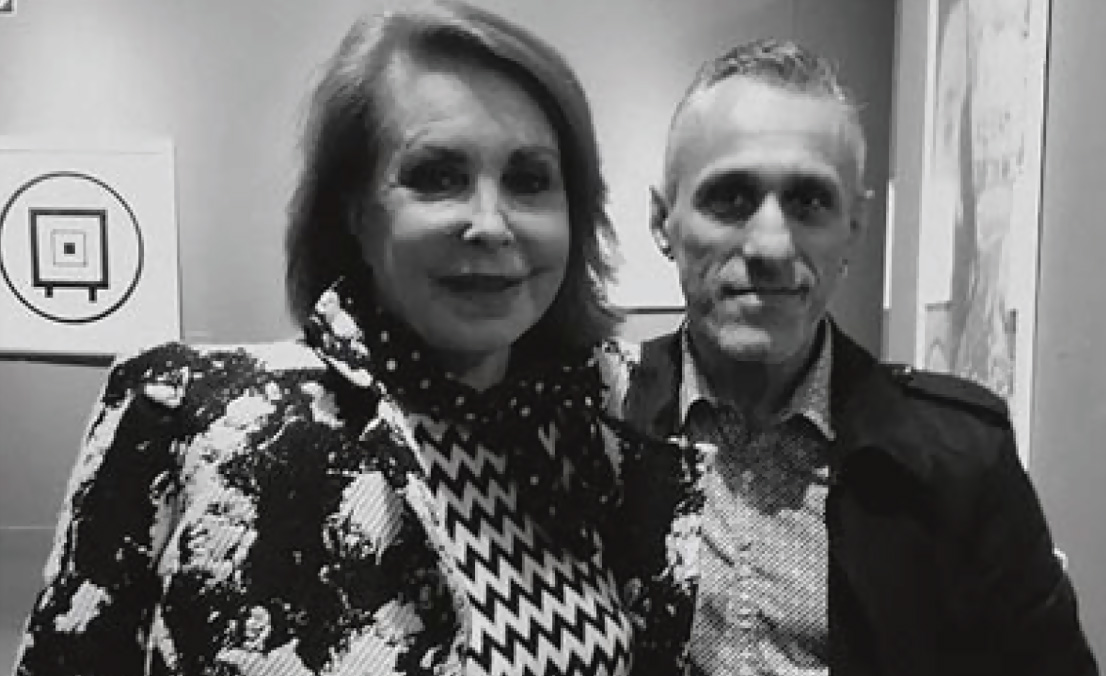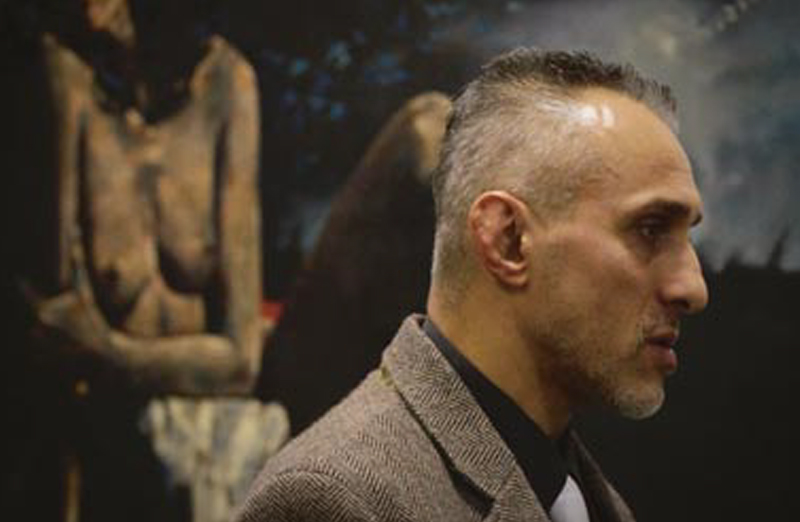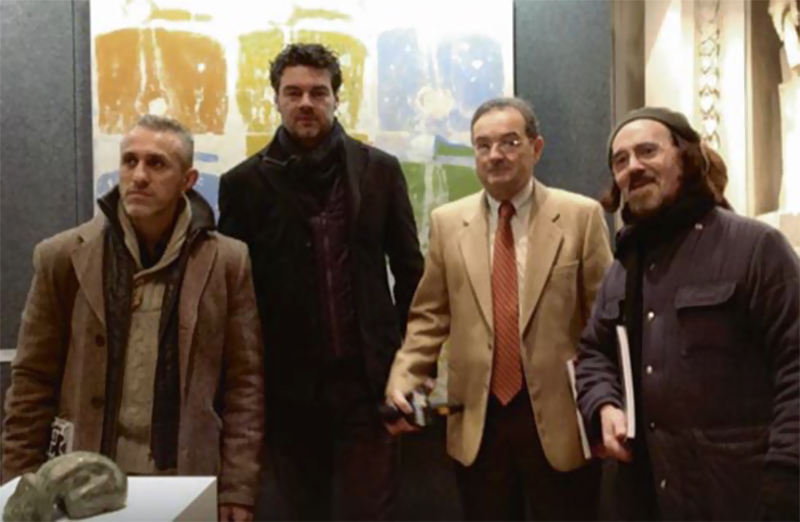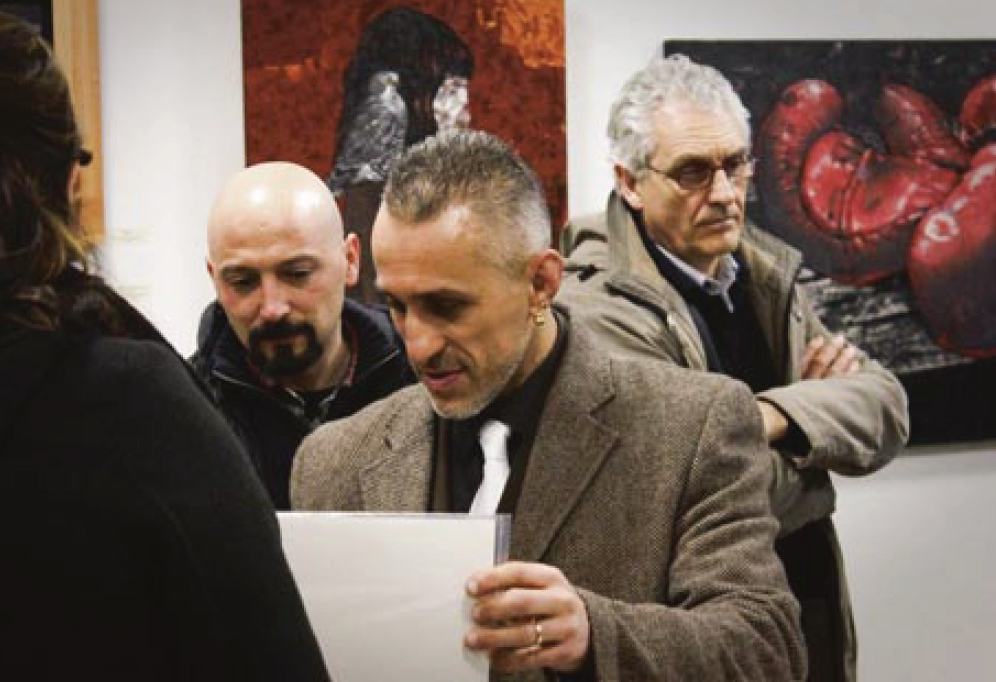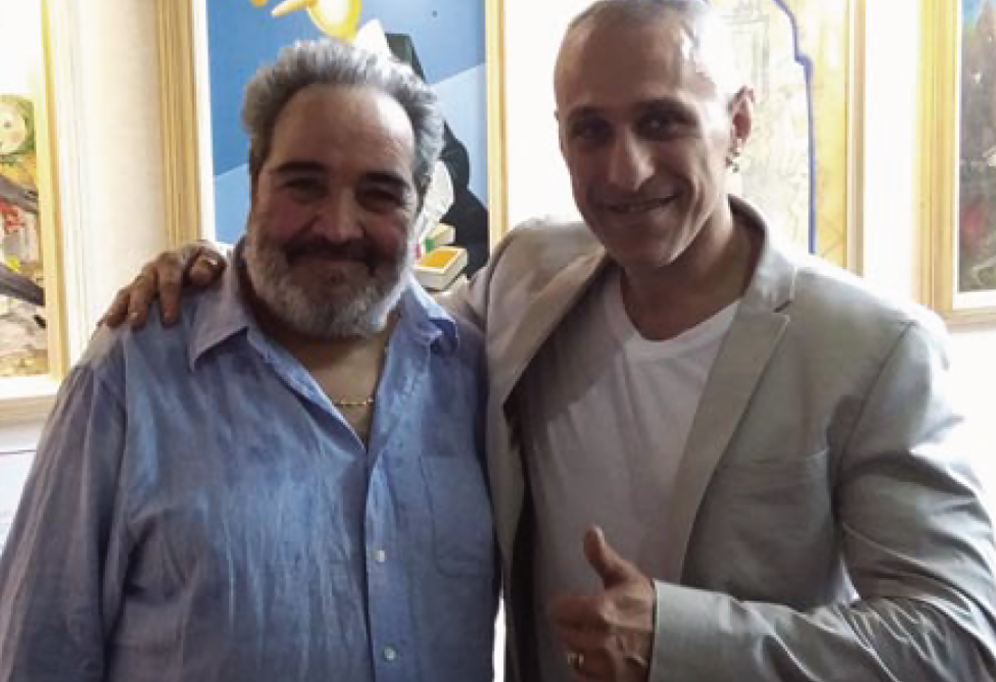Under the Skin – Studies in Salvation
by Fabio Norcini
“This life is short, it’s written on our skin”, sang the “damned Tuscan” Piero Ciampi, identifying the destiny that the human envelope reveals by concealing. Skin can be variously seen as the covering of a deceptive interior, as limitation and finite boundary: skin that changes, that can be wounded, that heals, wrinkles or regenerates. Skin like the title of a novel by Malaparte, but also like a wrapping to be protected at any cost.
On this surface, although using the most varied materials, the art of Tiziano Bonanni carves stinging representations, only to bestow consoling caresses. Operating in the very “body” of the figure, his art has no need of the symbolic sphere, can add endlessly, mingling through masterly technical control the most widely varied modes of expression: sculpting, painting and drawing cross the border to join the ready-made and even the installation. This might be called baroque, except that the artist’s attraction to the non-finito is transformed into a yearning for the in-finite. Hence he manages, thanks to an innate sense of the classical conferred by his stubborn Tuscan DNA, to remain ancient.
In this regard, we may cite such masters as the architect Pier Niccolò Berardi, whom he met while very young, or wizards of colour and design such as Calderai and Cecco Ceccherini, masters who have transmitted to Bonanni that art of making typical of the Renaissance art workshop. Bonanni has developed a boundless love, almost a cult, for his city, where the facades of its palazzi and houses appear as old familiar faces. Along with this is a sense of the figurative, realistic and plastic narration that surveys all of the most vivid artistic manifestations, in a line that, in times closer to our own, stretches from Viani to abstraction and is (not by chance) classic. For him it is entirely natural to make us believe in the myth of artistic creation, through its intrinsic beauty and not through rational, convoluted persuasion. In such a totality of artistic power the parallel with Malaparte’s aesthetics emerges powerfully.
We could apply to our artist what Luigi Baldacci perceptively notes in regard to the author’s experimentation with the range of expressive possibilities: “On closer inspection, what seems old-fashioned in Malaparte’s prose is above all old-fashioned in regard to the moment; but yesterday’s old-fashioned can be profitably revisited today”.
On closer inspection, the inappropriateness of today in Bonanni’s figurative expression can be reassessed tomorrow. A sub-cutaneous question, then, but one that is also skin-deep: a question of experience, desire and regret, with all the burden of wrinkles and scars that this implies. Nor should we forget his practice of the martial arts, where Bonanni has reached notable levels, learning most importantly that every victory is first of all a defeat. And this explains a certain irony and self-mockery, an element deeply entrenched in the region of Tuscany. Man is, in fact, also Ness1 – Nessuno, or No One – as proclaims the title of one of his works. Expressly because the framework of his creations lies in drawing, devoid of any mannerism, Bonanni can allow himself to demolish the false and the illusionary, to find the flesh of reality; without presuming to operate always for the present and always on the right side but, with Brecht, observing that “since all the other places were already taken, we sat on the side of the wrong”. Without the contorted intellectualism used to justify so much useless “up-todate” pseudo-artistic production, but entrusting only to poetry, to what springs exclusively from reality, grasped and re-elaborated by a gifted hand, to reflect life as it is and not as we might wish it to be. “We think we are struggling and suffering for our souls, but we are really struggling and suffering for our sins”, even merely by pursuing the chimera of a beauty presumed still practicable. It is a difficult undertaking, but one that can be attempted, even by applying it to the tissue of the ever-changing, infinite epidermis that is painting: art is long, is written on the skin.
Florence, 2014
“His works are permeated by an emotional dichotomy that echoes with clarity those feminine figures appearing as subject, usually examined, beyond their fascinating appearance, in those inner facets unknown to the many where the controversial dregs of existence have settled.”
(Giovanni Faccenda, 2012)
“After having thoroughly studied the great Florentine Masters, the artist seems to have assimilated from them a tension toward a kind of painting linked to his own intrinsic qualities, while not ignoring a factor of considerable importance, that of drawing.”
(Miriam Giustizieri, 2009)
Border line
a cura di Nicola Micieli
It is surprising that pictorial experimentation as dense and significant in its development, as lucidly aimed at attaining its stylistic and poetic objectives, and as capable in the technical and stylistic means utilized to achieve them, as that of Tiziano Bonanni, has not yet attracted sufficient attention from the critics, and is justly appreciated only within a narrow circle of connoisseurs residing mainly in Tuscany. The young painter, while treasuring his native land’s great artistic tradition, clearly understands that we come even closer to the genius loci when we interrogate it through the manifold stimuli provided by knowledge of and sensitivity toward our own contemporary world. That is, with the critical incidence and the anxious sensitivity, the sense of disorientation and the obscure need of anchorage to a core of identity characteristic of our disquieting age. An age that experiences in a state of drifting reason the downfall of historic ideologies, and imposes as democratic model, on the planetary level, the one-way-street ideology of the market and consumerism.
Where the dominant powers possessing more technology (including weapons) and economic resources, claim the “freedom” to govern processes of development that prevail over and discriminate a mosaic of peoples and cultures of ancient and noble civilization.
Peoples and cultures whose common denominators are poverty and a total lack of any hope for the future. Must we recall that this includes a conspicuous part of humanity? […]
Tiziano Bonanni, in fact, can claim personal responsibility for the shadowy veil behind which the severe plant of his art has budded and thrived with undeniable vigour. This is not sunny, extroverted painting, nor one able to seduce the gaze by displaying, for instance, a festive gown of brilliant colours, or by pulling from a magic hat a surprising repertory of caprices, tricks, inventions, excitement and visual aberrations designed to strike wonder into the heart of the onlooker Nor is it a kind of painting that captures the gaze and draws it in by the oblique, twisting path of psychological provocation, entrusting treacherously and even truculently to a wide range of the different and often correlated fetishes and myths that are constituent elements of cultures in the anthropological sense. This is material skilfully manipulated and dosed today by the hordes of so-call “creatives”, mainly at the service of the advertising industry: nature, machinery, power, erotica, war, blood, death and, in a word, anything symbolical that implicates the magmatic territory of the profound, and moves it by triggering mechanisms that are more or less complicated and automatic.
The art of Tiziano Bonanni, on the contrary, tends toward reflection and plans an executive project on a conceptual basis. His is an art thought out as well as acted. Not by chance, it is based on the analytical and structural function of drawing, which in his case remains the primary tool of investigation and the principle imposing order on space and form […] Bonanni’s painting, even in its most optically immobile and formally compact versions, possesses fevers, combustions, troubles, dynamics of inner response, radiant luminosity, blossoming and chromatic “festivals”, bizarre aspects, flights of the imagination, erotica, and primordial latencies, among them, unspoken and widespread, the impulse toward nullification, the irresistible attraction – although exorcized and sublimated – for the void and for death. These themes, both central and conflictual, are treated visually as an emphasis on the figures within the artificial enclosure of space, which is often a cage, a box, a prison, a closed-off area, or in any case bounded and separated through bold framing of photographic nature, looming incumbent in forced or shortened perspectives and intersecting planes or bulwarks that cut through the bodies, clipping short their movements. […] Such more or less urgent and conscious manifestations of being are present and active in these works, but as if shielded. They are consumed, we might say, under the skin of the figures inhabiting the scenic box, solitary and virtually sovereign; but they burn without crackling or shooting off sparks, without ignition or pyrotechnical uproar, emerging here and there in impure colours, in the play of chiaroscuro and the spotting of an epidermis, in the swelling and deflating of nude bodies, in extenuated postures.
They appear even in the segmented shredding of clothing and drapery, often utilized not so much in homage to the academic tradition of nude painting, but as plastic and chromatic accessories to the staging, as vectors that collect and shoot out in different directions through space the motions triggered by the presence, not neutral but perturbing, of virile ancillary figures. Well beyond their canonical primacy, the centrality of the representative order of the painting, and as ideal places of measurement, these figures emerge as corporal entities pervaded with humours, arousing senses and tensions incommensurate to the space that contains, or rather imprisons them. Hence they serve a symbolic function, an added value, but not one translatable into specific literary contents. […] The rich typology of Tiziano Bonanni’s images results from a process of combining components, a process that descend from an historical context and expressive spheres, which is to say from numerous and diverse artistic sources. Bonanni has selected and hybridized the material he works, after a long formative period spent in exploring the possibilities of declining the figurative language, from precise analytical surveying of an objective truth to the summary restitutions of a truth so expanded, in his interweaving, as to appear almost deconstructed and bordering on the formless.[…]
As for his Tuscan roots, Tiziano Bonanni has certainly studied the 15th-century organizers of visual space, the strict architects of form presided over by the divine drawing. His interest, however, must have been focussed on the Mannerists influenced by Michelangelo, attracted especially by their extenuated vision of line and form, which calls into question the ratio imposing order and insinuates in the human spirit the feeling, already modern, of submerged elements dominated by dark, irrational forces, of mystery. We are in the wake of Beccafumi and Pontormo, masters evoked in Bonanni through an expressive climate rather than by explicit stylistic references or even significant clues.
That of Bonanni is, as has been seen, a highly important stylistic background and cultural context. Considering the work matured by him through a long, tenacious process of selection and study of the materials and subjects appropriate to each occasion, and taking account of the work done not by artists tout court, but expressly by the painters of his generation, I am again surprised that Tiziano Bonanni has not yet been assigned an important place in the lively panorama of the art of the image in Tuscany, and I speak of image rather than generically of figuration, to indicate a precise aspect of the visual research he offers us, with the formal and aesthetic quality of the work, which is also a document – I was about to say, a report – on the existential temperature of our time.
Responsibility for the lack of attention, as previously mentioned, must be assigned primarily to the artist himself. He has chosen to work dividing his time between research in the studio and teaching, rather than in displaying his work in the media and on the market. He has preferred to focalize and translate into figural substance his own world of vision rather than to cultivate or promote his image through appropriate strategies of marketing and communication.
These are basic choices and omissions, which have been repaid with low visibility, in a system that rewards flagrant display, noise, aggressive provocation and the dominant presence of the media. With what works, with what significance and duration, does not matter. In today’s system of communication, the message is instead almost an optional, because what counts is acting on the channel and on the code. What the artist has to communicate, in fact, is his own existence as a name, a brand, a creative agency, not as the marginal note, the appendix, the incident that his work consists of in the end. Now it is just the persistence and the central nature of the work that struck me when I visited the Florentine studio of Tiziano Bonanni. I do not intend to mystify by referring to the practice and spirit of the Renaissance workshops, but it is certain that Bonanni’s studio has retained many of their characteristics.
Expressly in the sense of the artist’s relationship to his work, of the choice and preparation of the materials used in planning and execution. He does not anachronistically simulate the old, but conducts with the integrity and wisdom of the old masters a research into the image that holds a desire for beauty but also the torments of a man of our own time.
Florence, 2004


